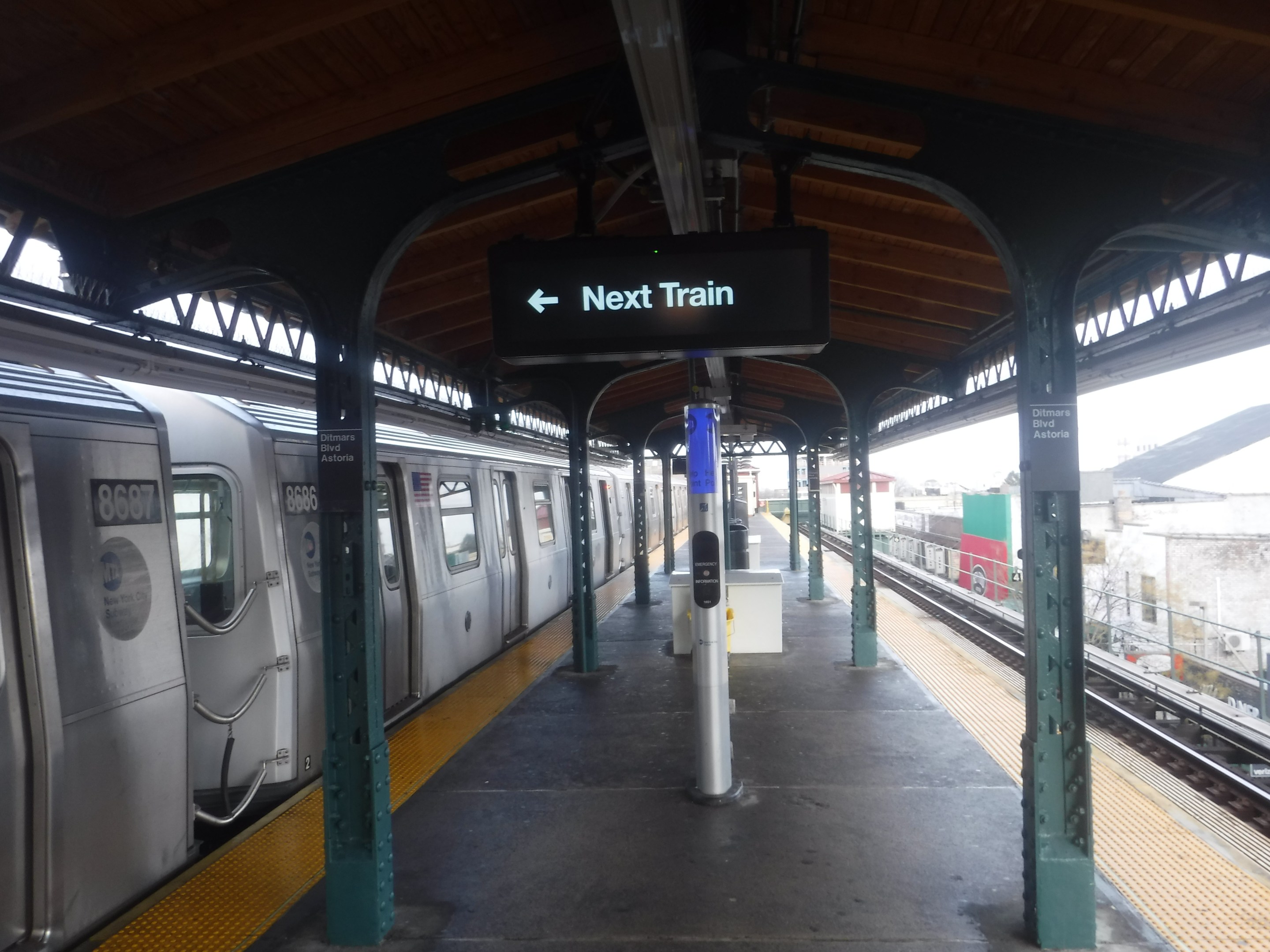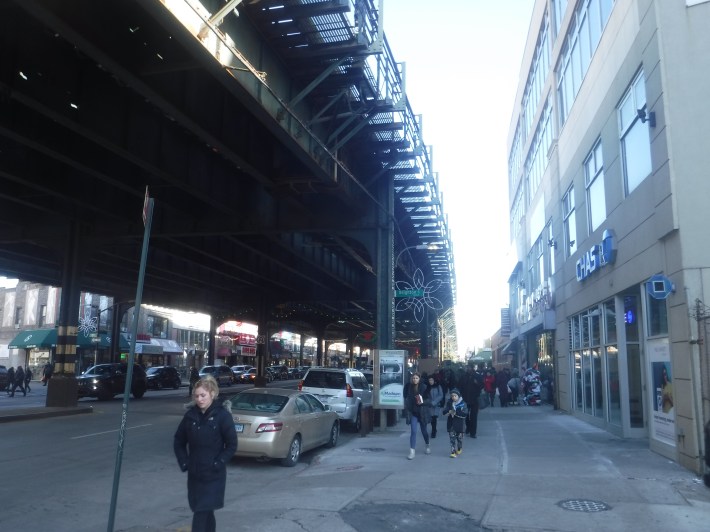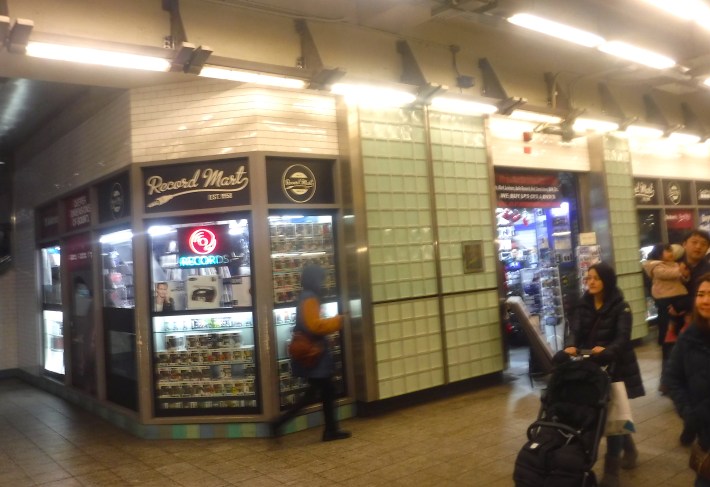A Chicago transit enthusiast’s look at New York City public transportation
7:21 PM CST on January 2, 2020

New York’s Astoria/Ditmar’s Boulevard station platform. Photo: Igor Studenkov
The last time I was in New York City, a friend of mine -- a Florida native who’s been to Chicago before and rode the ‘L’ -- commented that, while he liked many things about NYC's subway, there are two things that could use improvement: turnstiles wide enough to accommodate strollers and heat lamps at platform shelters.
Four years later, that still holds true.
“They put up all the fancy displays on the platforms, and they can’t put up any heaters?” he complained when I visited during the Christmas week. “We’re two stories up, in the cold.”
I’ve been to New York City a few times since my friend and his partner moved there from Florida. From the get-go, North America’s largest subway system impressed me with its sheer scale, the elaborate elevated structures that put anything in Chicago to shame, the convenient intermodal connections and all of the small businesses below and above ground. But I continue to be amazed at the many small, but important ways it still falls short.
General Impressions
If my entire Streetsblog output hasn’t made it obvious by now, I love public transit. I trace that love to the St. Petersburg Metro, the subway system in my native St. Petersburg. Buried deep underground, its original stations are downright palatial, and the newer stations are striking and architecturally distinct. One sentiment I hear from my fellow Peterburgians who visited Chicago is how poorly the ‘L’ looks by comparison, and to a certain extent, I agree. But I’ve also come to appreciate the ‘L’ on its own merits. St.Petersburg subway has awe-inspiring stations and dark tunnels running in between. The ‘L’ gives you a view of the city high above the streets, along the highways and over the Chicago River, and the elevated track structures give so much of the city character.
The New York Subway feels almost like the ‘L’ on steroids. After all, most of its trackage outside Manhattan is actually either elevated or in the trenches. Most lines have more than two sets of tracks. There are underground and, more impressively, elevated stations where trains arrive on two separate levels. The complexity of some underground transfer stations rivals some of what I knew back in St. Petersburg. You get sections of lines that run under and on the side of suspension bridges. And because the tracks and the stations are larger and more complex, you get some impressive arches and overpasses.

The same thing applies to the train cars. It took me a bit to notice that many train cars I rode had three doors, and only then did I notice that they were physically longer (60-75 feet vs the ‘L’s 48 feet and 3 inches) and wider (by a few inches). The shorter length of Chicago's trains is due to necessity: ‘L’ cars have to maneuver around tight curves on the Loop and several other elevated segments.
One thing I always found interesting is that, unlike other rapid transit systems in North America, New York Subway lines aren’t, strictly speaking, lines, in the sense that they have dedicated segments that rarely, if ever, change. They are more akin to routes, in that they get shifted along the existing infrastructure on fairly regular basis. For example, when I first visited my friends in New York, the Q train used to go from Astoria to Coney Island, But in 2017 its northern terminal was moved to 92nd Street station in East Harlem, serving the Second Street Subway tracks that opened for service at the start of 2017. Now, it isn’t as if changing which lines use which tracks is unheard of in Chicago. To give the most recent example, I was there when Pink Line was created out of what used to be Blue Line’s Douglas branch and other existing trackage. But it seems to happen a lot more frequently in New York, and it seems like less of a big deal when it does.
Speaking of routes, the first time I was in New York, my friends took me to see the L train (not to be confused with the Chicago 'L' train), because we all thought it would be funny to get some photos of the New York L. And while the novelty of that wears out pretty quickly, there’s another reason for Chicagoans to visit it: 14th Street - Eighth Avenue station’s distinctive sculptures.
It is interesting to see how New York City’s district five boroughs geography influenced public transit. Local bus routes have prefixes that correspond to the boroughs they serve – so the “M” in “M11,” for example, indicates that it serves Manhattan. On the subway, the trains aren’t “inbound/outbound” – they are “Manhattan-bound,” “Queensbound,” etc.
And one thing that impressed me about how many different modes of transportation the New York City transit includes. Not as many as Boston, or San Francisco, but there aren’t many transit systems in United States that include ferries, and I would recommend taking the Roosevelt Island Tramway for the sheer novelty of it, and the cool views.
The Positive
Now, comparing the New York Subway and the Chicago ‘L’ isn’t entirely fair. The former is much larger in terms of trackage and the area it covers, it carries more riders than any other transit system on the continent and has an operating budget other United States transit agencies would envy. But there are still a few things that Chicago could take some cues from.
While the system is Manhattan-centric (more on that later), and there are service gaps, it is impressive how many neighborhoods the subway lines reach. One of the great original sins of the Chicago ‘L’ is that there are several lines bunched close together, and there are large sections of the city that either lost ‘L’ service or never had any to begin with. I can see why the construction of the Orange Line was as big of a deal as it was back in the day. And while many areas of Chicago have Metra and, in case of Hyde Park and Hegewisch, South Shore Line service, the frequencies, the distance-based fares, and lack of free transfers to the CTA reduce the utility of the service for city dwellers.
While the Chicago ‘L’ only offers connections to two out of its four rail terminals – Millennium Station and LaSalle Station. New York Subway doesn’t have that problem. New York Penn Station is directly served by three Subway stations, while Grand Central Station has one. There are also convenient connections to the PATH (a transit system linking that, due to unusual historic circumstances, became something of a subway/commuter rail hybrid), and the aforementioned ferries.

It’s no secret that ‘L’ stations have many retail spaces that go unfilled. It’s certainly not for the lack of trying on CTA’s part, and I like the art installation and DJ booth artist Theaster Gates designed for the new 95th-Dan Ryan Red Line station’s north terminal. But I continue to be impressed by how much retail there is on mezzanines and even at platform level in New York. At it’s not just Dunkin Donuts and newsstands. During my latest trip, for example, I came across a record store at the Times Square station. And there are examples like Silver Age Comics, where the Astoria/Ditmars Blvd station mezzazine connects directly to the comic book store at the adjacent building. From what I understand, the some of the ‘L’ Loop station used to have diverse retail, but these small businesses didn’t survive.
The Negative
First of all, let’s talk about the heat lamps. Even though they work better at some stations than others, and they only warm exposed skin, at least they exist in Chicago. During my visits, I never had to stand on an elevated platform for too long, but as someone who has plenty of time waiting on ‘L’ platforms, I shudder to think (pun intended) what that would feel like without any sort of reprieve.
Chicago's larger, more wheelchair/stroller-friendly fare gates were one of those things I didn't appreciate until I found myself in a system where they simply don’t exist. There is no comfortable way to get the luggage through regular turnstiles, and, from what I saw, it’s not uncommon for parents with strollers to simply push open the emergency gates rather than trying to deal with the turnstiles. The station attendant just kind of accepts it. I imagine, given the sheer size of the New York Subway, adding new fare gates systemwide would be expensive, but it seems like it would be a worthwhile upgrade.
Speaking of which, the CTA has been criticized, not without merit, for having many stations that aren’t wheelchair accessible. In some ways, New York Subway’s situation has improved since my first visit: There are more ramps and more elevators. But as the July 17, 2018 report by the New York City Comptroller’s office points out, the ‘L’ is still ahead of the curve compared to the New York City subway. As of July 2018, 71 percent of the CTA's 145 stations were accessible. But as of July 2019, only 25 percent of the MTA's 472 stations, were accessible. And, in a related issue, I was surprised to realize how few stations, elevated of underground, have escalators.
While the New York subway service is extensive, it has an issue common among transit systems, including the ‘L’: The lines tend to follow a hub-and-spokes pattern, with most lines running through the city center. For example, in Chicago if you want to ride the train from the Central/Lake Green Line station to the Jefferson Park Transit Center, you have to head all the way east into the Loop, and then head northwest, which makes for a very indirect route. Likewise, New York Subway riders who wish to get from Queens to Brooklyn usually have to go through Manhattan, which adds extra time. Unlike Chicagoans, New Yorkers at least have one alternative for this trip, the G Line service, but it is has shorter trains and longer frequencies than lines that go through Manhattan.
And, since I mentioned the convenient connections to rail terminals, it would only be fair to mention that Chicago is better when it comes to airport connections. O’Hare and Midway are served by the Blue and Orange lines that provide a convienient, one-seat connection to downtown. LaGuardia Airport has no rail connections whatsoever. And there is no way to reach JFK Airport without transferring to the AirTrain JFK from one of the subway lines it connects to.
Finally, something that really struck me this time around is that unlike on the ‘L’, the train announcements never say “doors open on the [direction] at [station].” You just kind of have to watch what the other passengers are doing and hope for the best. And this isn’t a trivial thing, given how often sides change, and how sides often differ depending on whether the train is a local or an express.
Read More:
Stay in touch
Sign up for our free newsletter
More from Streetsblog Chicago
Today’s Headlines for Thursday, April 26
The de-facto ban on riverwalk biking is back. What should we do about it?
In the short term, new signage is needed to designate legal areas for cycling on the path. In the long term CDOT should build the proposed Wacker Drive protected bike lane.


